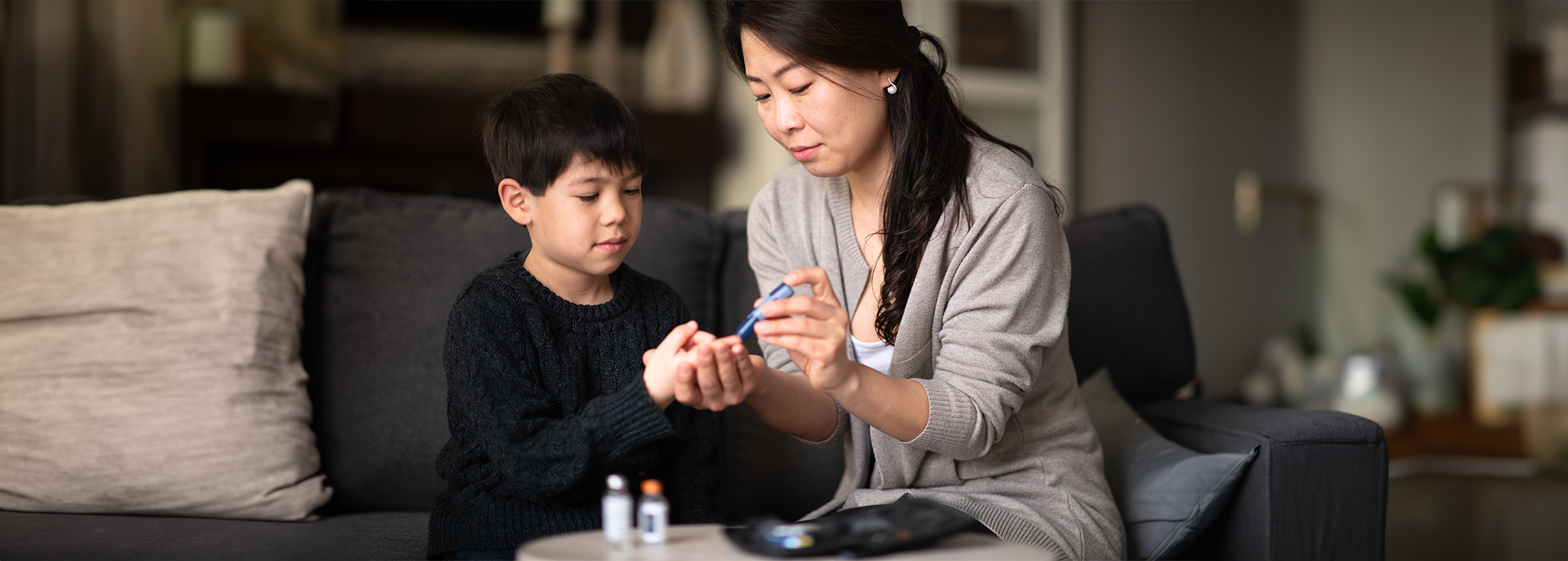Screening My Kid for Diabetes: A T1D Mother’s View
Written by: Eugenia Araiza
4 minute read
March 16, 2022
Editor’s Note: Anyone can get tested for the autoantibody markers of type 1 diabetes through JDRF’s T1Detect program. Read about this author’s son’s perspective on getting screened here.
Being a mom has been one of the clearest dreams I’ve had in my life. I would visualize the face my son would have and get excited about what he would be like. Fortunately, my wishes came true almost 17 years ago when Indigo was born.
However, that dream was often overshadowed by comments from doctors and even people close to me that filled me with fear of my son developing diabetes. There was even a person who asked me “how can you do that to a child?!”—the “that” being the risk he would, like me, have a chronic disease and all that it implies.
My path to pregnancy while living with T1D
For over 26 years I have lived my life with diabetes the same way I would without it. Perhaps life has been much better because I have decided to do things that someone who does not live with diabetes might not do—not because they can’t, but simply because they do not feel the need to demonstrate that diabetes is a lifelong condition that came to stay and was never asked for.
However, of all the things I have done, having my son gave me the most fear. It’s difficult to silence the voices, news and research surrounding pregnancy when living with diabetes.
When I decided to have Indigo, there wasn’t a diabetes community like we have today. I knew some people who lived with it, but there wasn’t the support there is now. So I decided to prepare, study and surround myself with health professionals who showed me empathy and who did not dissuade me from having a child. On the contrary, they encouraged me to take care of myself to achieve a healthy and full-term pregnancy.
Making the decision to test
Sixteen years later I learned through Beyond Type 1 and JDRF about the possibility of testing my son to detect autoantibodies that could indicate the development of type 1 diabetes. It took me months to decide to do it. Although I wasn’t looking for a reason not to, I was simply letting time pass. Knowing myself, if I don’t do something in the moment, it is because deep down there is a reason to wait.
In this case, it was fear.
At the end of 2021, my family and I had COVID. Despite having taken precautions and getting vaccinated, we caught it. Fortunately, the symptoms were mild, and in Indigo’s case, it was no more than a hoarse throat and discomfort for a couple of days—no fever, no other symptoms, he just lost his voice.
Around the same time, the
Centers for Disease Control and Prevention (CDC) issued a report on the risk of newly diagnosed diabetes in children who had COVID, something that coincided with a trend I saw in my private nutrition and diabetes management practice of some new, young clients whose parents reported them having had COVID. Again, alarm bells went off in my head.
Two weeks after the COVID tests came back negative, we decided to get Indigo a FreeStyle Libre sensor to monitor his blood glucose. Yes, this was one more way for me to postpone the decision to test him. The glucose levels were normal and a few days before the sensor ended I asked Indigo, “Do you want to get tested for type 1 diabetes?” He immediately replied, “Yes.”
I continued to ask him what he might think if he tested positive for one or more of the autoantibodies. “What would happen if you test positive? The risk for diabetes is high, you would have to enter a study, we would have to make changes, we would have to…”
To which he replied, “Calm down mom, we already know how to live with diabetes, the changes that would have to be made are few and we can, with the studies, lengthen the time before it would present itself.”
The calm with which he spoke and the clarity of his answer reassured me, but also generated another concern: “Indigo, if you test positive for any of the autoantibodies it’s my fault, I caused it, you inherited it from me.”
His response was again very clear: “No mom, it’s not your fault, if it turns out that way, it’s because that’s how it was meant to be, just as I was meant to have brown eyes or have my hair the way it is. Anything I may have is not your fault, they are just situations I’ll need to learn to live with if they come up, if they even come up.”
The decision was clear and I ordered the test, which arrived a few days later. The test stayed on the kitchen counter for days until Indigo took it and asked me, “Aren’t you going to test me?” We did the test, we sent it and we waited.
Waiting for results
Waiting is the worst. That uncertainty of knowing if something can or cannot change the course you imagined not only for your life but that of your child, is very difficult. The emotion that haunted me the most was guilt.
However, when I talked to my husband, who also lives with diabetes, we agreed––neither of us, not for a moment, blamed our parents for our diabetes. Quite the contrary. We have been so grateful for their support at every moment. I asked my mom if she ever felt guilty and her answer was, “Yes.” That feeling of guilt even reached my grandparents because each one thought that this condition must have come “from their side.”
For parents of children with diabetes, guilt is one of the biggest side effects. When you live with diabetes and have children, the guilt is greater, because there is no one for your children to turn to except for you, the parent living with diabetes. However, as a family, through trust and especially through communication, we as parents can not only find calm but also the strength to test our children and know that we are prepared for any scenario and that diabetes can be lived with. Your life with diabetes can even be healthier and fuller than that of someone who feels healthy and has no limitations.
In the end, the result came back in only a few days: negative for all autoantibodies. This, as the report says, is not definitive nor does it mean that he will not develop them in the future. This only indicates that today, at this moment, he does not have them.
We’ll keep monitoring every few years so that we can enroll Indigo in prevention studies if needed, and avoid a common situation when people aren’t on the lookout for symptoms of type 1 diabetes, diabetic ketoacidosis (DKA).

Author
Eugenia Araiza
Eugenia, creator of Healthy Diabetes, has a degree in nutrition and is a diabetes educator and health coach. She is also the author of the children's book “Soy Diferente y Me Gusta” (“I Am Different and I Like It”). She was diagnosed with type 1 diabetes at age 16.
Related Resources

Living with a chronic condition like type 1 diabetes (T1D) can impact your mental health...
Read more

While type 1 diabetes (T1D) makes up only between 5-10 percent of all diabetes cases,...
Read more

Months or years before blood sugar levels start to climb and type 1 diabetes is...
Read more

